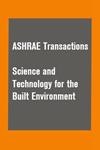Multi-deconvolution in non-stationary conditions applied to experimental thermal response test analysis to obtain short-term transfer functions
IF 1.6
4区 工程技术
Q3 CONSTRUCTION & BUILDING TECHNOLOGY
Science and Technology for the Built Environment
Pub Date : 2023-06-08
DOI:10.1080/23744731.2023.2217729
引用次数: 0
Abstract
Thermal response test interpretation methods usually rely on the assumptions of constant operating conditions in time. However, through desired or undesired processes, these conditions often vary in time. Since interpretation is usually done with stationary methods, no current algorithm allows to account for non-stationarity in thermal response test, as encountered with varying flow rate. The goal of this article is to apply a multi-deconvolution algorithm to retrieve a set of short-term transfer functions during a thermal response test with changing operating conditions. The deconvolution algorithm uses an optimization-based technique as the inverse model, while considering non-stationarity in the forward model through a recent non-stationary convolution algorithm. By optimizing a set of nodes on each estimated short-term transfer function, precise reconstruction of the experimental temperatures is possible. Results show that temperature reconstruction is as precise as an error of 0.06 °C on numerical cases and 0.07 °C on field cases. The usable transfer function duration and an analysis of the objective function’s optimum are also demonstrated. With the proposed algorithm, only the dataset of a thermal response test is needed to obtain short-term transfer functions when operating conditions are changing.将非平稳条件下的多次反褶积应用于实验热响应测试分析,获得短期传递函数
热响应测试解释方法通常依赖于恒定运行条件的假设。然而,通过期望的或不希望的过程,这些条件经常随时间而变化。由于解释通常是用平稳方法完成的,目前没有一种算法允许考虑热响应测试中的非平稳性,因为遇到了变化的流量。本文的目标是应用多重反卷积算法来检索一组短期传递函数在热响应测试与变化的操作条件。反卷积算法使用基于优化的技术作为逆模型,同时通过最新的非平稳卷积算法考虑正演模型的非平稳性。通过优化每个估计的短期传递函数上的一组节点,可以精确地重建实验温度。结果表明,温度重建精度在数值情况下为0.06°C,在现场情况下为0.07°C。给出了可用传递函数的持续时间和目标函数的最优分析。该算法只需要热响应测试数据集就可以获得工况变化时的短期传递函数。
本文章由计算机程序翻译,如有差异,请以英文原文为准。
求助全文
约1分钟内获得全文
求助全文
来源期刊

Science and Technology for the Built Environment
THERMODYNAMICSCONSTRUCTION & BUILDING TECH-CONSTRUCTION & BUILDING TECHNOLOGY
CiteScore
4.30
自引率
5.30%
发文量
78
期刊介绍:
Science and Technology for the Built Environment (formerly HVAC&R Research) is ASHRAE’s archival research publication, offering comprehensive reporting of original research in science and technology related to the stationary and mobile built environment, including indoor environmental quality, thermodynamic and energy system dynamics, materials properties, refrigerants, renewable and traditional energy systems and related processes and concepts, integrated built environmental system design approaches and tools, simulation approaches and algorithms, building enclosure assemblies, and systems for minimizing and regulating space heating and cooling modes. The journal features review articles that critically assess existing literature and point out future research directions.
 求助内容:
求助内容: 应助结果提醒方式:
应助结果提醒方式:


